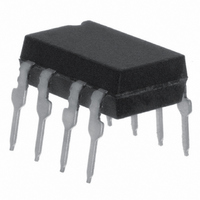IL300 Vishay, IL300 Datasheet - Page 6

IL300
Manufacturer Part Number
IL300
Description
OPTOCOUPLER HI GAIN WIDE BW 8DIP
Manufacturer
Vishay
Specifications of IL300
Mounting Type
Through Hole
Isolation Voltage
5300 Vrms
Number Of Channels
2
Input Type
DC
Voltage - Isolation
5300Vrms
Current Transfer Ratio (min)
0.56% @ 10mA
Current Transfer Ratio (max)
1.62% @ 10mA
Current - Dc Forward (if)
60mA
Output Type
Linear Photovoltaic
Package / Case
8-DIP (0.300", 7.62mm)
Current Transfer Ratio
0.5 % to 1.1 %
Forward Current
10 mA
Maximum Fall Time
1.75 us
Maximum Rise Time
1.75 us
Output Device
PIN Photodiode
Configuration
1 Channel
Maximum Forward Diode Voltage
1.5 V
Maximum Reverse Diode Voltage
5 V
Maximum Input Diode Current
60 mA
Maximum Power Dissipation
210 mW
Maximum Operating Temperature
+ 100 C
Minimum Operating Temperature
- 55 C
No. Of Channels
1
Optocoupler Output Type
Photodiode
Input Current
10mA
Output Voltage
50V
Opto Case Style
DIP
No. Of Pins
8
Gain Db Max
1.65dB
Lead Free Status / RoHS Status
Lead free / RoHS Compliant
Voltage - Output
-
Current - Output / Channel
-
Vce Saturation (max)
-
Lead Free Status / Rohs Status
Lead free / RoHS Compliant
Other names
751-1292-5
IL300GI
IL300GI
IL300GI
IL300GI
Available stocks
Company
Part Number
Manufacturer
Quantity
Price
Company:
Part Number:
IL300
Manufacturer:
Vishay Semiconductors
Quantity:
1 992
Company:
Part Number:
IL300
Manufacturer:
DALLAS
Quantity:
5 510
Part Number:
IL300
Manufacturer:
VISHAY/威世
Quantity:
20 000
Part Number:
IL300-C
Manufacturer:
SIEMENS/西门子
Quantity:
20 000
Part Number:
IL300-D
Manufacturer:
INFINEON/英飞凌
Quantity:
20 000
Part Number:
IL300-D-X007
Manufacturer:
VISHAY/威世
Quantity:
20 000
IL300
Vishay Semiconductors
www.vishay.com
6
Fig. 8 - Amplitude and Phase Response vs. Frequency
iil300_14
iil300_13
iil300_15
Fig. 10 - Photodiode Junction Capacitance vs.
- 100
- 110
- 120
- 130
- 10
- 15
- 20
- 60
- 70
- 80
- 90
14
12
10
- 5
8
6
4
2
0
5
0
10
10
0
Fig. 9 - Common-Mode Rejection
1
3
Mod = ± 4.0 mA
T
R
I
Fq
A
L
= 25 °C
= 50 Ω
= 10 mA
10
2
10
2
F - Frequency (Hz)
Reverse Voltage
F - Frequency (Hz)
4
Voltage (V
10
4
3
10
5
dB
Phase
For technical questions, contact:
10
6
det
4
)
10
6
10
8
5
Linear Optocoupler, High Gain
10
Stability, Wide Bandwidth
10
10
7
6
- 45
- 90
- 135
- 180
45
0
optocoupleranswers@vishay.com
APPLICATION CONSIDERATIONS
In applications such as monitoring the output voltage from a
line powered switch mode power supply, measuring
bioelectric signals, interfacing to industrial transducers, or
making floating current measurements, a galvanically
isolated, DC coupled interface is often essential. The IL300
can be used to construct an amplifier that will meet these
needs.
The IL300 eliminates the problems of gain nonlinearity and
drift induced by time and temperature, by monitoring LED
output flux.
A pin photodiode on the input side is optically coupled to the
LED and produces a current directly proportional to flux
falling on it. This photocurrent, when coupled to an amplifier,
provides the servo signal that controls the LED drive current.
The LED flux is also coupled to an output PIN photodiode.
The output photodiode current can be directly or amplified
to satisfy the needs of succeeding circuits.
ISOLATED FEEDBACK AMPLIFIER
The IL300 was designed to be the central element of DC
coupled isolation amplifiers. Designing the IL300 into an
amplifier that provides a feedback control signal for a line
powered switch mode power is quite simple, as the
following example will illustrate.
See figure 12 for the basic structure of the switch mode
supply using the Infineon TDA4918 push-pull switched
power supply control cChip. Line isolation are provided by
the high frequency transformer. The voltage monitor
isolation will be provided by the IL300.
The isolated amplifier provides the PWM control signal
which is derived from the output supply voltage. Figure 13
more closely shows the basic function of the amplifier.
The control amplifier consists of a voltage divider and a
non-inverting unity gain stage. The TDA4918 data sheet
indicates that an input to the control amplifier is a high
quality operational amplifier that typically requires a + 3 V
signal. Given this information, the amplifier circuit topology
shown in figure 14 is selected.
The power supply voltage is scaled by R1 and R2 so that
there is + 3 V at the non-inverting input (V
voltage is offset by the voltage developed by photocurrent
flowing through R3. This photocurrent is developed by the
optical flux created by current flowing through the LED.
Thus as the scaled monitor voltage (V
change in the LED current necessary to satisfy the
differential voltage needed across R3 at the inverting input.
The first step in the design procedure is to select the value
of R3 given the LED quiescent current (I
gain (K1). For this design, I
servo photocurrent at I
data R3 can be calculated.
R3 =
V
I
PI
b
=
100 µA
3 V
Fq
is found to be 100 mA. With this
Fq
= 12 mA. Figure 4 shows the
= 30 kΩ
Document Number: 83622
a
) varies it will cause a
Rev. 1.6, 10-Nov-10
Fq
) and the servo
a
) of U1. This
17164












